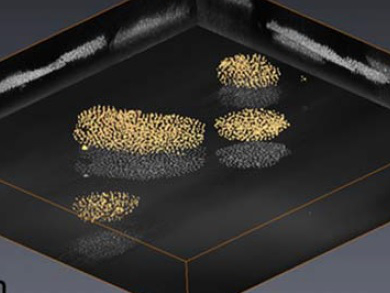Changing the size, crystallinity, or orientation of poly(3-hexylthiophene) (P3HT) domains in solar cells affects their light absorption and charge mobility. Christopher Tabor and colleagues found that light absorption can be tuned by incorporating polystyrene-coated gold nanoparticles in P3HT:PC61BM bulk heterojunction films.
The coated nanoparticles impart morphological changes within the film that lead to unique properties. The polystyrene shell separates from P3HT domains, creating distinct phases in the P3HT:PC61BM film. The nanoparticles assemble into ordered domains that reduce the amount of film defects that cause inefficiencies in electron absorption. The result is a higher fill factor, which directly determines the maximum power of a solar cell.
The gold in the nanoparticles form plasmons, ordered oscillations of electrons, which increase the light absorption range. By varying the processing conditions and amount of nanoparticles, the range can be tuned in order to create more efficient solar cells.
- Controlled dispersion of polystyrene-capped Au nanoparticles in P3HT:PC61BM and consequences upon active layer nanostructure,
Dennis P. Butcher, Robert C. Wadams, Lawrence Drummy, Hilmar Koerner, Chris Bailey, Frank Scheltens, David Mccomb, Laura Fabris, Michael F. Durstock, Christopher Tabor,
J. Polym. Sci. Part B Polym. Phys. 2015.
DOI: 10.1002/polb.23962



